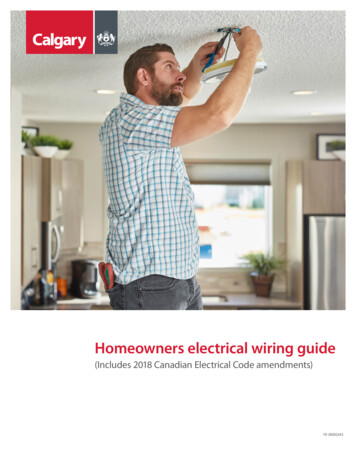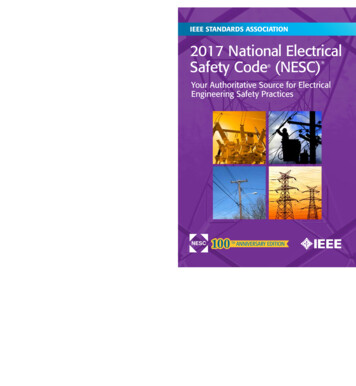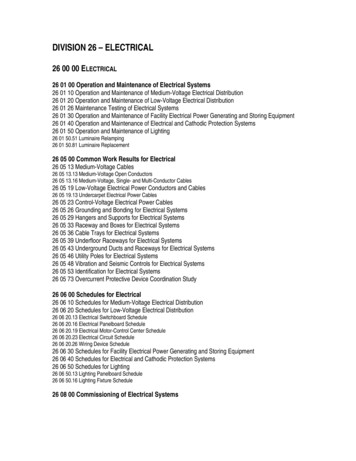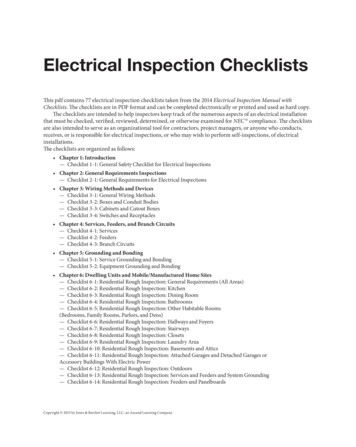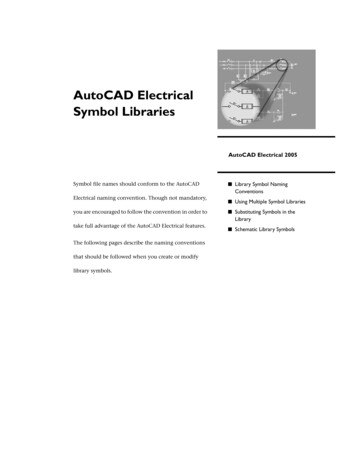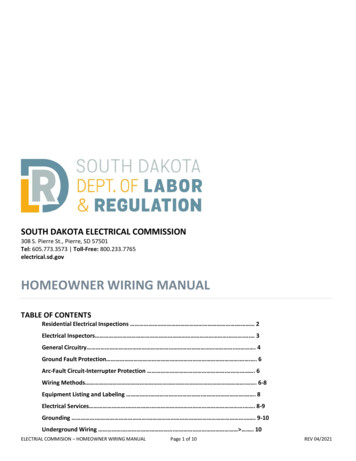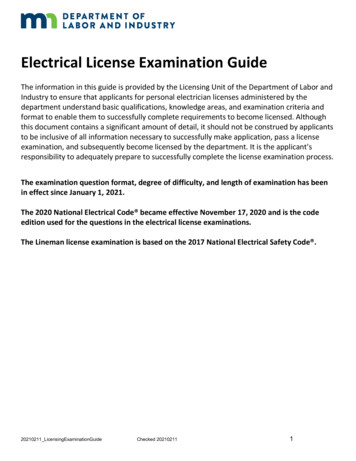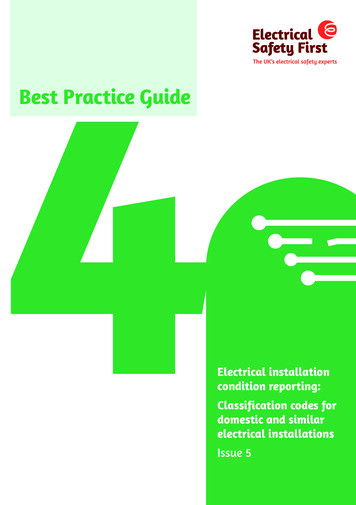
Transcription
4Best Practice GuideElectrical installationcondition reporting:Classification codes fordomestic and similarelectrical installationsIssue 5
Best Practice GuideElectrical Safety First is indebted to the followingorganisaƟons for their contribuƟon and/orsupport to the development of this Guide:Best Practice GuideElectrical Safety First is indebted to the followingAESMBEAMAon and/ororganisaƟons for their contribuƟwww.aesm.uk.comwww.beama.org.uksupport to the developmentof this Guide:In electronic format, this Guide is intended to bemade available free of charge to all interested parties.Further copies may be downloaded from the websitesof some of the contributing organisations.The version of this Guide on the Electrical Safety First websiteBest Practice Guide(www.electricalsafetyfirst.org.uk)alwaysbe the latest.In electronic format, thiswillGuideis intendedto be made avaElectrical Safety First is indebtedBEAMAto the followingorganisaƟons for their contribuƟon and/orBriƟsh Gaswww.beama.org.uksupport to the k fromon anyofwebsitesthe Best Practiceis always ng organisaƟontheof someGuidesof the contribuƟBEAMABriƟsh Gaswww.beama.org.ukBSI Product h Gas ServicesBSI mwww.certsure.comBSIProduct ServicesCertsurewww.bsigroup.comCity & eCityEAL & .org.ukCityEAL & GuildsInsƟtuƟon of Engineeringwww.cityandguilds.comwww.eal.org.ukand Technologywww.theiet.orgEALECAInsƟtuƟon of Engineeringwww.eal.org.ukwww.eca.co.ukand tuƟon of Engineeringand kwww.thespaces.org.ukof charge to all interested parƟes. Further copies may be dwelcome - email: this GuideintendedSafetyto be FirstmadewebsavaTheversion offormat,this Guideon theisElectricalofcharge to all interestedparƟes. Furthercopiesbe d(www.electricalsafety rst.org.uk)will alwaysbe maythe latesfromthesomeof the contribuƟorganisaƟonon anyofwebsitesthe Best ofPracƟce Guidesis always ngwelcome– emelectrical bpg@electricalsafety industry, approvals and rst.org.ukresearch bodies,Theversion offormat,this Guideon theisElectricalSafetyelectronicthisGuideintendedto be eelectricaldistribution(www.electricalsafety rst.org.uk)willbetheElectricalFirst is e Safetyto all interestedparƟes. byFurthercopiesbeindustry, anyofapprovalsthe Best ofPracƟce Guidesis alwayswelcome– essomeof fety rst.org.ukbodies, tradeand industryand federations,organisaƟons, theassociationselectricaldistribuƟon industry, professioTheversionof thisGuide onbodies,the ElectricalSafetyFirst websand andinsƟlocaltuƟons,regulatorytrade andindustryassotrade s supportedby allalwayssectors ofthethelateselec(www.electricalsafety rst.org.uk)federaƟons, trade unions,and localwilland ies,consumerintereson any of the Best PracƟce Guides is always welcome – em*Electrical SafetyFirst ElectricalSafety(formerlyonal forInspecƟon Cobpg@electricalsafety rst.org.ukthe NaƟElectrical InstallationContracting)a charitablenon-profitmakingandinsƟtuƟons, regulatorybodies,and industryassotElectricalInstallaƟonis ContracƟng)istradea charitablenon-pro ElectricalSafetyFirstsupportedalluserssectorsof the elecaorganisationset up inons,1956to overnmenorganisaƟon tradesetupunions,inis1956toelectricityprotectof electricityapprovalsandresearchbodies, consumerinteresthe hazardsindustry,of ons,Safety(formerlythe NaƟonal InspecƟon CoorganisaƟtheFirstelectricaldistribuƟon industry,professioElectricalInstallaƟon ContracƟng) istradea charitablenon-pro andinsƟtuƟons, regulatorybodies,and industryassotorganisaƟon tradeset upunions,in 1956andto protectusersof electricityafederaƟons,local andcentralgovernmenhazards of unsafe and unsound electrical installaƟons.*Electrical Safety First (formerly the NaƟonal InspecƟon CoElectrical InstallaƟon ContracƟng) is a charitable non-pro torganisaƟon set up in 1956 to protect users of electricity ahazards of unsafe and unsound electrical installaƟons.Electrical Safety First is supported by all sectors of thePublished byElectrical Safety First45 Great GuildfordStreetPublishedby:LondonElectrical Safety FirstSE1 0ES Unit 331Publishedby:MetalBox FactoryEmail: enquiries@electricalsafetyfirst.org.uk30 Great Guildford StreetElectrical Safety FirstUnit 331MetalBox FactoryTel:02035100Publishedby:Electrical SafetyFirst463andother contributors believe that theNAPIT30 Great Guildford fety rst.org.ukguidance andinformationcontainedin thisBest Practice Guide aces.org.ukUnit331correct, butall partiesmust rely on their ownrst.org.ukskill and judgementWebsite:www.electricalsafety n making use of it.ElectricalSafety Firstand otherrst.org.ukcontributors believe that safety Several of the photographsin this Guide have been extractedSELECTandinformaƟoncontainedin this BestassumesPracƟceanyGuide is coLondonSE1 0HSwww.thespaces.org.ukNeither ElectricalSafetyFirstnor any contributorfrom a superseded ElectricalSafety First DVD, courtesy ofWebsite:www.select.org.ukall parƟeswww.electricalsafety must rely on their ownrst.org.ukskill and judgement whenNavigator ProducƟons Ltd. Others were kindly supplied by Nick liability toTel:0203463anyoneany5100lossor damagecausedanyanyerroruseof Electrical Safety First and other contributors believe that thBlakeley Electrical and Bradford Metropolitan District Council.or e by ral of the photographs in this Guide have been extractedEmail:bpg@electricalsafety eGuide is coSELECTomission inthisGuide,whethersucherror orisomissionis urtesy ofThis isa oneof a seriesof BestPracƟceGuidesbyresult of negligenceoranyothercause.Wherereferencemadeall parƟeswww.electricalsafety must rely on their ownrst.org.ukskill and judgement whenWebsite:www.select.org.uknegligence or any other cause. Wherereference is made toNavigatorProducƟons inLtd.Othersonweresuppliedby bodiesNickElectrical SafetyFirst*associaƟwithkindlyleadingindustryuse itofisit.notNeitherElectrical SafetyFirstnor anyto legislation,to be consideredas legaladvice.Any contributorand allit is not toSafetybe consideredas legalcontributorsadvice. Any and all thatsuchthlBlakeleyElectricaland BradfordMetropolitanDistrict Council.for the bene t of electricalcontractorsand installers,and theirElectricalFirst andanyisliabilityto anyonefor otherany loss or damagebelievecaused by mission in this Guide, whether such error or omission is tThis isa oneof a seriesof Best SafetyPracƟce froma supersededElectricalSafety FirstFirstDVD,DVD,courtesyofallparƟes mustrelyon theirownskill erereferenceis madeto SafetyElectricalCouncil.May2015Electrical gatorProducƟons inLtd.Othersonweresuppliedby bodiesNick ElectricalJuly 2019 Safety First nor any contributorNavigatorProductionsLtd. Otherswere kindlysupplied byuseof it.toCouncil.NeitherElectricalit is notbe consideredas legal advice. Any and all such lfor the bene t of electricalcontractorsand installers,andNicktheirBlakeleyElectricaland BradfordMetropolitanDistrict Council.anyliability to anyone for any loss or damage caused by andisclaimed.BlakeleyElectrical and Bradford Metropolitan District Council.customers.omission in this Guide, whether such error or omission is tThis is one of a series of Best PracƟce Guides produced byLondon SE1 0HSWebsite: www.electricalsafetyfirst.org.uk
Page 3IntroductionEvery electrical installation deteriorates with useand time. Therefore, if the safety of the users isnot to be put at risk, it is important that everyinstallation is periodically inspected and tested bya competent person. Indeed, it is recommendedin BS 7671: 2018 that every electrical installationis subjected to periodic inspection and testing(Regulation 135.1 refers).Electrical installationcondition reporting:Classification codesfor domestic and similarelectrical installationsThe inspection and testing should be carried outat appropriate intervals in order to determinewhat, if anything, needs to be done to maintain theinstallation in a safe and serviceable condition.The aim of this Guide is to provide practicalguidance for skilled persons competent inInspecting a socket-outletelectrical inspection and testing on the useof the Classification Codes that need to beatiributed to each observation recordedduring the periodic inspection and testing ofan electrical installation for the benefit of theperson ordering the report.The guidance is limited to the range ofobservations that are likely to be associatedwith domestic and similar electricalinstallations. It takes into account thepublication of BS 7671: 2018.The results of the inspection and testing need to beclearly detailed in a report. Any observed damage,deterioration, defects, dangerous conditions andnon-compliances with the requirements of thecurrent edition of BS 7671 that may give rise todanger should be recorded (Regulation 653.2) andappropriately classified for remedial action.It should be borne in mind that, as stated in theintroduction to BS 7671, existing installations thathave been constructed in accordance with earliereditions of the Standard may not comply with thecurrent edition in every respect, but this does notnecessarily mean that they are unsafe for continueduse or require upgrading.
Page 4Electrical InstallationCondition ReportPurpose of periodic inspection,testing and reportingAs its title indicates, this is a report and not acertificate. It provides an assessment of the currentin-service condition of an electrical installationagainst the requirements of the edition of BS 7671current at the time of the inspection, irrespective ofthe age of the installation.The main purpose of periodic inspection and testingis to detect so far as is reasonably practicable, andto report on, any factors impairing or likely to impairthe safety of an electrical installation.The report is primarily for the benefit of the personordering the work and of persons subsequentlyinvolved in additional or remedial work, or furtherinspections. The report may be required for oneor more of a variety of reasons, each of which mayimpose particular requirements or limitations onthe inspection and testing.The report is required to include details of theextent of the installation and of any limitationsof the inspection and testing (Regulation 653.2)including the reasons for any such limitationsand the name of the person with whom thoselimitations were agreed. It should be noted that thegreater the limitations applying, the lesser is thescope of the inspection and testing carried out, andhence the value of the report is correspondinglydiminished. The report is also required to include arecord of the inspection and the results of testing.The report provides a formal declaration that,within the agreed and stated limitations, thedetails recorded, including the observations andrecommendations, and the completed schedulesof inspection and test results, give an accurateassessment of the condition of the electricalinstallation at the time it was inspectedA typical periodic inspection notice for an older installationElectrical installations in poor condition presentrisks of fire as well as electric shockThe aspects to be covered include all of thefollowing: Safety of persons against the effects of electricshock and burns Protection against damage to property by fireand heat arising from an installation defect Confirmation that the installation is notdamaged or deteriorated so as to impair safety Identification of non-compliances with thecurrent edition of BS 7671, or installationdefects, which may give rise to danger.
Page 5The inspectorAll persons carrying out periodic inspection andtesting of existing electrical installations must becompetent (electrically skilled) to do so.Electrical tests being carried outTo be competent, persons must as a minimum: Have sufficient knowledge and experience ofelectrical installation matters to avoid injury tothemselves and others Be familiar with, and understand, therequirements of the current edition of BS 7671including those relating to periodic inspection,testing and reporting Be skilled in the safe application of theappropriate test instruments and testprocedures Have a sound knowledge of the particular typeof installation to be to be subject to periodicinspection and testing Have sufficient information about the functionand construction of the installation to allowthem to proceed in safety.Guidance on safe isolation procedures is available inanother Best Practice Guide No.2 ‘Guidance on themanagement of electrical safety and safe isolationprocedures for low voltage installations’ publishedby Electrical Safety First, which can be downloadedfree of charge from www.electricalsafetyfirst.org.ukand the websites of some of the other contributingbodies.
Page 6Periodic inspection andtesting proceduresThe procedures for periodic inspection and testingdiffer in some respects from those for the initialverification of new installation work. This is becausethe subject of an electrical installation conditionreport is usually an installation which has beenenergised and in use for some time. Particularattention therefore needs to be given during theinspection process to assessing the condition of theinstallation in respect of: Safety Wear and tear Corrosion Damage and deterioration Excessive loading Age External influences Suitability (taking account of any changes inuse or building extensions etc).Also, for reasons beyond the inspector’s control, theinspector may be unable to gain access to parts ofthe existing installation. For example, it is usuallyimpracticable to inspect cables that have beenconcealed within the fabric of the building.Such restrictions are likely to result in the inspectionand testing of those parts of the installation beinglimited, or being omitted entirely from the process.Inadequate provision for socket-outletsWhere a limitation exists - whether agreed oroperational - it should be recorded on the ElectricalInstallation Condition ReportWhere, during the course of inspection or testing,an immediate danger is found to be present in aninstallation (from an accessible exposed live part,for example), immediate action will be necessaryto make it safe before continuing. However, thediscovery of the dangerous condition should still berecorded in the report and classified accordingly.Inspectors should note that, even in domesticpremises, Section 3 of the Health and Safety atWork etc Act 1974 and the Electricity at WorkRegulations 1989 effectively require them, withthe agreement of the user or owner, to endeavourto make safe, before leaving site any dangerousconditions found in an installation.For example, where there are accessible, exposedlive parts due to blanks missing from a consumerunit, suitable temporary barriers should be providedto protect persons from direct contact with thoselive parts.As persons using the installation are at risk, itis not sufficient simply to draw attention to thedanger when submitting the electrical installationcondition report. At the very least, the inspectormust ensure that the client is made aware, at thetime of discovery, of the danger that exists. Anagreement should be made with the client as to theappropriate action to be taken to remove the sourceof danger (for example, by switching off and isolatingthe affected part of the installation until remedied),before continuing with the inspection or testing. Insome cases, this may prevent inspection and testingwork from continuing.
Page 7Some certification, registration and membershipbodies make available ‘dangerous conditionnotification’ forms. These assist inspectors torecord, and then to communicate immediately to theperson responsible for the safety of the installation,any dangerous condition discovered.The observations should be based on therequirements of the edition of BS 7671 current atthe time of the inspection, not on the requirementsof an earlier edition current at the time theinstallation was constructed.Each observation should be written in a clear,accurate and concise manner that is likely to beunderstood by the person ordering the work.Technical terms should be avoided or explainedunless it is known that the recipient is an electricalengineer or electrician, for example.An electrical installation condition report isintended to be a factual report on the condition ofan installation, not a proposal for remedial work.Therefore, each recorded observation shoulddescribe a specific defect, omission or item forwhich improvement is recommended.The observation should detail what the situation is,and not what is considered necessary to put it right.An immediately dangerous situation - Lineconductor connected to the metallic enclosureof a light fitting and thermal damagesufficient to permit access to live partsObservationsThe periodic inspection and testing proceduresshould identify any damage, deterioration, defectsand conditions within the installation that give rise,or potentially give rise, to danger. The proceduresshould also identify any deficiencies for whichremedial action would contribute to a significantimprovement in the safety of the electricalinstallation.For example, ‘excessive damage to the consumerunit enclosure’ would be appropriate, whereas‘consumer unit to be replaced’ would not.Only observations that can be supported by one ormore regulations in the edition of BS 7671 currentat the time of the periodic inspection should berecorded. The particular regulation number(s) neednot be entered in the report (unless specificallyrequired by the client), but should serve to remindthe inspector that it is only compliance with BS 7671that is to be considered. Observations based solelyon personal preference or ‘custom and practice’should not be included.After due consideration, each such observed safetyissue should be recorded at the appropriate point inthe inspection or test results schedule, and furtherdetailed in the ‘observations’ section of the report.Recessed luminaire above a bath (ouside the zones)that is not IPX4 would not warrant a comment
Page 8Classification CodesEach observation relating to a concern about thesafety of the installation should be attributed anappropriate Classification Code selected from thestandard codes C1, C2, C3 and FI. Each code has aparticular meaning:Code C1‘Danger present’. Risk of injury.Immediate remedial actionrequired.Code C2‘Potentially dangerous’.Urgent remedial action requiredCode C3‘Improvement recommended’.Code FI‘Further investigation required’Only one of the standard Classification Codesshould be attributed to each observation. If morethan one Classification Code could be attributed toan observation, only the most serious one shouldbe used (Code C1 being the most serious). Wherethe inspection and testing procedures identify anitem which is dangerous or potentially dangerous,it should be identified in the inspection or testresults schedule of the report by attributing to it aClassification Code C1 or C2, as appropriate, in the‘outcome’ column of the inspection schedule or,where provided, the ‘remarks’ column of the testschedule.Where the inspection and testing proceduresidentify an item which is not dangerous orpotentially dangerous, but for which improvementis recommended, it should be identified in theinspection or test results schedule of the reportby attributing to it a Classification Code C3 in the‘outcome’ column of the inspection schedule or,where provided, the ‘remarks’ column of the testschedule.Where during inspection and testing an immediatedanger is observed that puts the safety of thoseusing the installation at risk, Classification Code C1(danger present) must be given.Live parts exposed to touchWhere a Classification Code C1 is consideredappropriate, the client is to be advised immediately,and also in writing, that immediate remedial action isrequired (or has been taken) to remove the danger.As previously indicated, this action is necessary tosatisfy the duties imposed on the inspector and otherduty holders by the Health and Safety at Work etc Act1974 and the Electricity at Work Regulations 1989.Wherever an item in the inspection or test resultsschedule has been attributed a Classification CodeC1, C2, C3 or FI, there should be a correspondingobservation in the ‘observations’ section of the report.
Page 9In general terms, theClassification Codes should beused as follows:Code C1 - Danger present Risk of injury.(Immediate remedial action required)This code should be used to indicate that dangerexists, requiring immediate remedial action. Thepersons using the installation are at immediaterisk. The person ordering the report should beadvised to take action without delay to remedy theobserved deficiency in the installation, or to takeother appropriate action (such as switching off andisolating the affected parts of the installation) toremove the danger. The inspector should not waitfor the full report to be issued before giving thisadvice. As previously indicated, some certification,registration and membership bodies make available‘dangerous condition notification’ forms to enableinspectors to record, and then to communicateimmediately to the person ordering the report, anydangerous condition discovered.Code C2 - Potentially dangerous(urgent remedial action required)This code should be used to indicate that, whilstan observed deficiency is not considered to bedangerous at the time of the periodic inspection,it would become an immediate danger if a faultor other foreseeable event was to occur in theinstallation or connected equipment. The personordering the report should be advised that, whilstthe safety of those using the installation may not beat immediate risk, remedial action should be takenas a matter of urgency to remove the source ofpotential danger.Code C3 - Improvement recommendedThis code should be used to indicate that, whilst anobserved deficiency is not considered to be a sourceof immediate or potential danger, improvementwould contribute to a significant enhancement ofthe safety of the electrical installation.FI - Further investigation required without delayUsually, it should be possible to attribute aClassification Code to each observation without theneed for further investigation.The purpose of periodic inspection, as previouslystated, is not to carry out a fault-finding exercise,but to assess and report on the condition of aninstallation within the agreed extent and limitationsof the inspection. Therefore, where an observationcan be attributed a Classification Code, furtherinvestigation would not be required for thepurposes of completing the condition report.Further investigation should be called for inrespect of any observation that could reasonablybe expected to reveal danger or potential danger.Further investigation should not be called for simplybecause it would be ‘nice to know’ – for example,why a socket-outlet is unearthed.If an observation cannot be attributed aClassification Code due to reasonable doubt asto whether danger or potential danger exists, theoutcome of the assessment must be reported to beunsatisfactory.The person ordering the report should be advisedthat the inspection and/or testing has revealeda potential safety issue which could not, due tothe agreed extent or limitations of the inspection,be fully determined, and that the issue shouldbe investigated as soon as possible. Examples ofobservations that might possibly justify furtherinvestigation are given on page 16.Non-compliances with the requirementsof the current edition of BS 7671 thatdo not give rise to danger and do notrequire reporting.Examples of such non-compliances are given onpage 17.
Page 10Summary of the conditions ofthe installationThe summary should adequately describe thegeneral condition of the installation in terms ofelectrical safety, taking into account the specificobservations made. It is essential to provide a clearsummary of the condition of the installation havingconsidered, for example: The adequacy of the earthing and bondingarrangements The suitability of the consumer unit and othercontrol equipment The type(s) of wiring system, and its/theircondition The serviceability of equipment, includingaccessories The presence of adequate identification andnotices The extent of any wear and tear, damage orother deterioration Changes in use of the premises that have led to,or might lead to, deficiencies in the installation.Minimal descriptions such as ‘poor’, and superficialstatements such as ‘recommend a rewire’, areconsidered unacceptable as they do not indicatethe true condition of an installation.After due consideration, the overall condition of theinstallation should be given as either ‘satisfactory’or ‘unsatisfactory’ in the appropriate place on thecondition report.If any observation in the report has been given aCode C1 or Code C2 classification as categorised inthis Guide, or if any observations require furtherinvestigation (FI) to determine whether danger orpotential danger exists, the overall assessment ofthe condition of the installation must be reportedto be ‘unsatisfactory’.If there are no observations in the report classifiedas C1, C2 or FI, it would not be reasonable toreport the overall condition of the installation asunsatisfactory.The recommended interval until the nextinspection should be made conditional upon allobservations that have been given a ClassificationCode C1 (danger present) being remediedimmediately and all observations that have beengiven a Code C2 (potentially dangerous) or thatrequire further investigation being remedied orinvestigated respectively as a matter of urgency.Where the space provided for the description of thegeneral condition of the installation is insufficientfor the purpose, the page numbers of any additionalpages used should be recorded.It will often be necessary or appropriate to explainthe implications of an electrical installationcondition report in a covering letter, for the benefitof recipients who require additional advice andguidance about their installation.For example, where an installation has deterioratedor been damaged to such an extent that its safeserviceable life can be reasonably considered to beat an end, a recommendation for renewal shouldbe made in a covering letter, giving adequatesupporting reasons. Reference to the covering lettershould be made in the report.Unsatifactory connection to a downlighter, requiring a Code C2
Page 11Examples of the use ofCode C1 - Danger presentClassification Codes It is entirely a matter for the competent personconducting the inspection to decide on theClassification Code to be attributed to anobservation. The inspector’s own judgement as acompetent person should not be unduly influencedby the person ordering the work. The person(s)signing the report are fully responsible for itscontent and accuracy. The following examples arenot exhaustive. All references to RCD protectionmean additional protection by an RCD having arated operating (tripping) current (IΔn) not greaterthan 30 mA.Exposed live parts that are accessible to touch,such as where:-a fuse carrier or circuit-breaker is missing froma consumer unit and a suitable and securelyfitted blanking piece is not in its place-terminations or connections have no (ordamaged) barriers or enclosures-live conductors have no (or damaged)insulation-an accessory is badly damaged. Conductive parts have become live as theresult of a fault Incorrect polarity.Socket-outlet with broken face plate, requiring a Code C1
Page 12Code C2 - Potentially dangerous Absence of a reliable and effective means ofearthing for the installation A public utility water pipe being used as themeans of earthing for the installation A gas or oil pipe being used as the means ofearthing for the installation Cross-sectional area of the earthing conductordoes not satisfy adiabatic requirements (that is,does not comply with Regulation 543.1.1) Absence of a circuit protective conductor fora lighting circuit supplying items of Class Iequipment, or connected to switches havingmetallic face plates1 Absence of a circuit protective conductor for acircuit, other than a lighting circuit, supplyingClass I equipment Absence of supplementary bonding whererequired2, such as in a location containing abath or shower, where any of the followingthree conditions are not satisfied:-All final circuits of the location comply withthe requirements of Regulation 411.3.2 fora
Best Practice Guide Electrical installation condition reporting: Classification codes for domestic and similar electrical installations Issue 5. In electronic format, this Guide is intended to be made available free


